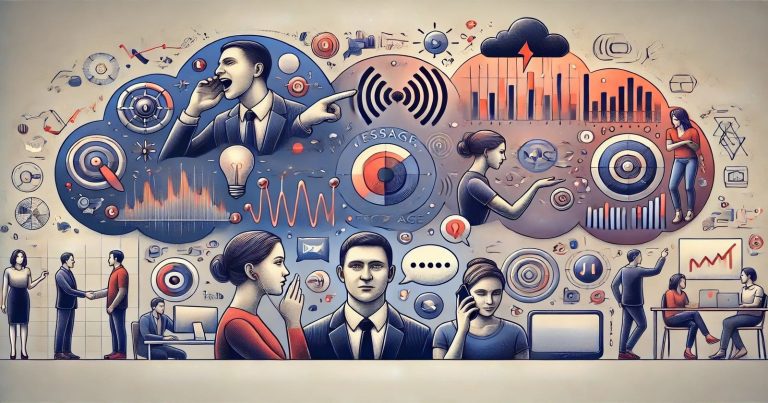Communication is the flow of information between people through a variety of channels. The communication process refers to those steps involved in sending and receiving messages between two or more individuals. The process consists of encoding, transmitting, receiving, and decoding messages. Components of communication play an important role in ensuring that messages are understood as intended. Successful communication includes key elements such as sender, receiver, message, channel, reaction, noise and reference. Without these major components of communication, effective interaction is impossible.
Eight Components of Communication
The elements of communication create the main structure of effective interactions. Without these elements, communication becomes disorganised and ineffective. Below are the major components of the communication process:
Sender (Source)
The sender is a person or unit starting communication. The sender generates an idea, converts it to a message, and distributes it to the receiver. The sender may be a speaker, teacher or leader in oral communication. In written communication, the sender may be a writer, journalist or company representative. A sender must ensure the message is clear and relevant to the receiver. Bad structured messages can cause misunderstandings and communication breakdowns. Leaders and managers act in commercial communication when they issue instructions or share reports.
Message
The message is real information or idea the sender wants to communicate. It can be oral, mascot or written. The message should be easier for well-organized, brief and successful communication. Messages can be formal (email, reports, presentations) or informal (casual conversation, phone calls). The choice of words, tone and structure affects the message received. For example, in marketing, brands carefully prepare their messages to attract and attract their target audiences.
Encoding
Encoding is converting an idea into a form that can be conveyed. This involves selecting words, symbols, gestures or images to represent the message. The sender has to encode the message in such a way that the receiver can easily interpret it. In written communication, encoding involves choosing appropriate words and structuring sentences effectively. Non-verbal communication encoding includes facial expressions, body language and gestures. Poor encoding can lead to confusion and misinterpretation.
Channel (Medium)
The channel is the medium via which the message is broadcast. It can be oral, mascot or written. Various channels include face-to-face conversations, cellphone calls, emails, social media, newspapers and TV broadcasting. The channel’s desire relies upon the message’s character and target market. For example, formal enterprise reviews are fine shared via email or revealed documents, even as contingency updates may be disbursed through an immediate message app. The choice of the proper channel increases readability and effectiveness.
Receiver
The receiver is the person or group that explains and processes the message. The effectiveness of communication depends on how well the receiver understands the message. In a commercial setting, employees act as receivers when managers give instructions or presentations. The role of the receiver is to listen, interpret and respond actively. Poor hearing abilities, distractions, or prefabricated assumptions can affect how the message is received. In customer support, an organisation must ensure that their conversation is clear and meets clients’ desires.
Decoding
Understanding the message decoding is how the receiver interprets and feels about the message sent by the sender. It converts obtained phrases, symbols, gestures, or written text into significant figures. The decisive effectiveness depends on the receiver’s knowledge, joy and caution. For example, in a business, an employee receiving an email from an observer must study carefully and understand the instructions before taking action. Similarly, in oral exchange, tone and body language receiver help explain a message’s real meaning.
Feedback
The response is the receiver’s response to the sender’s message. This guarantees that the message is correctly understood and allows for vital rationalization. Feedback may be oral, written, or fearful, along with shaking the head or making facial features. Effective conversation requires an active response. For example, in a lecture room, students reply by asking questions or answering the trainer’s rationalization. In place of work conferences, employees react through talk or written reviews.
Noise (Communication Barriers)
The noise refers to any intervention or disruption that affects the message. It can be physical noise (background voice), psychological noise (personal bias), semantic noise (language difference), or technical noise (network issues in digital communication). The noise creates misunderstandings and reduces communication effectiveness. In virtual meetings, poor internet connections can cause wrong communication. In face-to-face interaction, distraction and obstruction can disrupt the message flow. Reducing noise improves clarity and understanding.
How Does Communication Work?
Understanding the communication process is very important to develop communication skills. Several stages ensure a smooth flow of information. When these steps are followed correctly, the communication becomes clear and effective. A series of connected steps form the communication process, which is initiated when an individual or a group wishes to deliver a message to another group. All these include encoding, transmitting, receiving, and decoding the messages. With this process, the sender can send over the message it wishes to reach the receiver so that it, in turn, gets to receive the preferred feedback.
- Sender: This person has a thought or information intended to be conveyed.
- Encoding: In this process, the sender encodes the message; this is the transformation of the idea into a form that can be communicated, such as words, gestures, or visuals.
- Message: This is the actual message, the content of the communication, and the information or idea the sender wants to pass.
- Medium: The medium is the channel through which the message is sent. This can be face-to-face, emails, phone calls, or non-verbal communication.
- Receiver: The receiver is the person or group of people who receive the message and decode it.
- Decoding: The receiver decodes the message by interpreting the words or gestures and extracting meaning from the message.
- Feedback: Lastly, feedback is the process whereby the receiver gives a response to the sender regarding whether the message was received and understood.
- Noise: This refers to external factors that might distort or disrupt the message, including external physical noise, distractions, misunderstandings or differences in culture.
Tips to Improve Communication Process
To ensure effective communication, refining communication skills and avoiding misunderstandings are important. Below are some necessary suggestions:
Keep Message Simple
See clear, straight language to avoid unnecessary complexity. It is easy to understand a simple message and reduces the possibility of misinterpretation.
Understand your Audience
Tail your message according to the audience’s background, interests and expectations. Consider the level of knowledge on the subject and communicate accordingly.
Listen Actively
Good communication is not only about speaking -it also involves listening carefully. Attention to the speaker’s words, tones, and manifestations enhances understanding.
Ask Questions
Encourage open communication by asking relevant questions. This helps to clarify doubt, attach the listener to attach and ensure an accurate interpretation of the message.
Use the Correct Communication Medium
Select the best channel based on message type and urgency. A casual conversation can work well on the immediate message, while a formal business decision requires an email or meeting.
Maintain Positive Body Language
Non-verbal signs such as eye contact, asanas and gestures play an important role in communication. Make sure your body language aligns with your message.
Provide a Clear and Creative Response
Encourage the response and be open to suggestions. Effective response improves communication and helps both sides understand each other better.
Importance of Effective Communication
Special communication skills lead to many benefits in personal and professional life. Here are some advantages:
1. Confidence and Strong Relationships
Good communication promotes confidence between individuals and teams. Whether at home, at work, or in social settings, clear communication helps create permanent relationships.
2. Stops and Solves Conflicts
Effective communication reduces misunderstandings and prevents conflicts. It also helps to solve disagreements calmly and professionally.
3. Provides Clear Direction In Workplaces
strong communication skills enable leaders to give clear instructions. Employees who understand their tasks do better and contribute to organisational success.
4. Team Enhances Cooperation
A well-transmitted message encourages teamwork. When employees communicate openly, they work more efficiently and improve productivity.
5. Workplace Reduces Confusion
Clear communication prevents misinterpretation of tasks and responsibilities. This ensures that employees understand their roles and do them effectively.
6. Increases Engagement and Inspiration
Employees who hear and understand are more busy and motivated. Effective communication makes team members feel valuable and involved in making decisions. ,
Components of Communication FAQs
1. What are the components of communication?
Communication components include sender, message, encoding, channel, receiver, reaction and noise. These elements ensure that the information is effectively broadcast.
2. Why is response important in communication?
The response helps confirm whether the message was understood correctly. This allows for clarification, improves interactions, and ensures that communication is effective
.3. What is the difference between oral and mascoting communication?
Oral communication contains spoken or written words, while non-abusive communication includes body language, facial expressions and gestures. Both play a role in expressing messages effectively.
4. How does noise affect communication?
The noise disrupts the message transmission, causing misunderstandings. It can be physical (background noise), psychological (prejudice), or meaning (language barriers).
5. What are the major components of the communication process?
The major components of the communication process are sectors, messages, encoding, channels, receivers, reactions and noise. These elements ensure smooth and clear communication.


